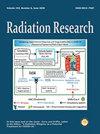Effects of Partial-Body, Continuous/Pulse Irradiation at Dose Rates from Flash to Conventional Rates on the Level of Surviving Blood Lymphocytes: Modeling Approach. I. Continuous Irradiation.
IF 2.5
3区 医学
Q2 BIOLOGY
引用次数: 0
Abstract
A mathematical model developed by Cucinotta and Smirnova is extended to describe effects of continuous, partial-body irradiation at high doses D and at dose N rates from FLASH to conventional rates on the level of surviving blood lymphocytes in humans and small laboratory animals (mice). Specifically, whereas the applicability of the model is limited to the exposure times shorter than a single cardiac cycle T0, the extended model is capable of describing such effects for the aforementioned and longer exposure times. The extended model is implemented as the algebraic equations. It predicts that the level of surviving blood lymphocytes in humans and mice increases with increasing the dose rate from N = D / T0 to FLASH rates and approaches the upper limiting level of 1 - v R where v R is the fraction of blood volume in the irradiated part of the blood circulatory system. Levels of surviving blood lymphocytes computed at doses from 10 Gy to 40 Gy and at dose rates N, which equal or exceed 40 Gy/s for humans and 400 Gy/s for mice, are nearly indistinguishable from the upper limiting level. In turn, the level of surviving blood lymphocytes in humans and mice decreases with decreasing the dose rate from N = D / T0 to conventional rates and approaches a lower limiting level. This level strongly depends on the dose D (it is smaller at larger values of D) with a slight dependence on the dose rate N. The model with the parameters specified for mice (together with the model of the dynamics of lymphopoietic system in mice after partial-body irradiation) reproduce, on a quantitative level, the experimental data, according to which the concentration of blood lymphocytes measured in mice in one day after continuous, partial-body irradiation at a high dose and conventional dose rate is smaller at the larger value of vR. Additionally, the model predicts at the same high dose (>10 Gy) a faster restoration of the blood lymphocyte population in humans exposed to continuous, partial-body irradiation at a FLASH dose rate compared to a conventional dose rate.从闪光到常规剂量率的局部全身连续/脉冲辐照对存活血液淋巴细胞水平的影响:建模方法。I. 连续辐照。
Cucinotta 和 Smirnova 建立的数学模型被扩展用于描述高剂量 D 和剂量 N 率(从闪烁率到常规率)下的连续部分全身辐照对人类和小型实验动物(小鼠)血液淋巴细胞存活水平的影响。具体来说,虽然该模型的适用性仅限于短于一个心脏周期 T0 的照射时间,但扩展模型能够描述上述和更长照射时间的影响。扩展模型以代数方程的形式实现。它预测人和小鼠血液淋巴细胞的存活水平会随着剂量率的增加而增加,从 N = D / T0 到 FLASH 剂量率,并接近 1 - v R 的上限水平,其中 v R 是血液循环系统中受辐照部分的血容量比例。在剂量为 10 Gy 至 40 Gy 和剂量率 N(对人类等于或超过 40 Gy/s,对小鼠等于或超过 400 Gy/s)条件下计算的血液淋巴细胞存活水平与上限水平几乎没有区别。反过来,随着剂量率从 N = D / T0 到常规剂量率的降低,人类和小鼠血液中存活淋巴细胞的水平也会降低,并接近下限水平。小鼠参数模型(连同小鼠部分全身辐照后淋巴造血系统动力学模型)在定量水平上再现了实验数据,根据这些数据,小鼠在高剂量和常规剂量率下连续进行部分全身辐照后一天内测得的血液淋巴细胞浓度在 vR 值越大时越小。此外,该模型还预测,在相同的高剂量(大于 10 Gy)下,与常规剂量率相比,以 FLASH 剂量率连续进行部分全身辐照的人体血液淋巴细胞群恢复得更快。
本文章由计算机程序翻译,如有差异,请以英文原文为准。
求助全文
约1分钟内获得全文
求助全文
来源期刊

Radiation research
医学-核医学
CiteScore
5.10
自引率
8.80%
发文量
179
审稿时长
1 months
期刊介绍:
Radiation Research publishes original articles dealing with radiation effects and related subjects in the areas of physics, chemistry, biology
and medicine, including epidemiology and translational research. The term radiation is used in its broadest sense and includes specifically
ionizing radiation and ultraviolet, visible and infrared light as well as microwaves, ultrasound and heat. Effects may be physical, chemical or
biological. Related subjects include (but are not limited to) dosimetry methods and instrumentation, isotope techniques and studies with
chemical agents contributing to the understanding of radiation effects.
 求助内容:
求助内容: 应助结果提醒方式:
应助结果提醒方式:


